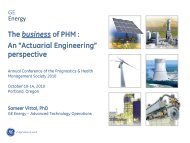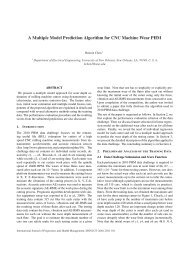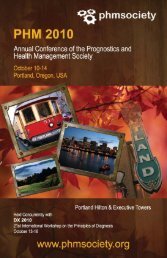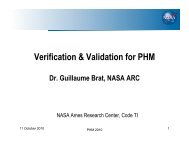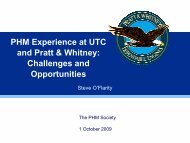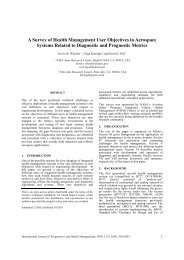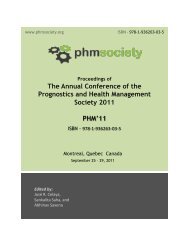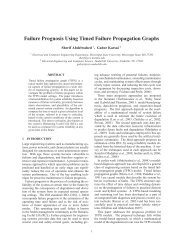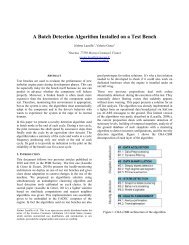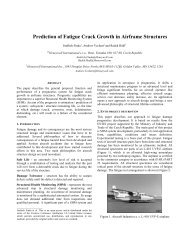Bearing fault detection with application to PHM Data ... - PHM Society
Bearing fault detection with application to PHM Data ... - PHM Society
Bearing fault detection with application to PHM Data ... - PHM Society
You also want an ePaper? Increase the reach of your titles
YUMPU automatically turns print PDFs into web optimized ePapers that Google loves.
<strong>Bearing</strong> <strong>fault</strong> <strong>detection</strong> <strong>with</strong> <strong>application</strong> <strong>to</strong><br />
<strong>PHM</strong> <strong>Data</strong> Challenge<br />
Pavle Boškoski 1 , and An<strong>to</strong>n Urevc 2<br />
1 Jožef Stefan Institute, Ljubljana, Slovenia<br />
pavle.boskoski@ijs.si<br />
2 Centre for Tribology and Technical Diagnostics,<br />
Faculty of Mechanical Engineering,<br />
University of Ljubljana, Slovenia<br />
an<strong>to</strong>n.urevc@ctd.uni-lj.si<br />
ABSTRACT<br />
Mechanical <strong>fault</strong>s in the items of equipment can result in partial<br />
or <strong>to</strong>tal breakdown, destruction and even catastrophes. By<br />
implementation of an adequate <strong>fault</strong> <strong>detection</strong> system the risk<br />
of unexpected failures can be reduced. Traditionally, <strong>fault</strong><br />
<strong>detection</strong> process is done by comparing the feature sets acquired<br />
in the <strong>fault</strong>y state <strong>with</strong> the ones acquired in the <strong>fault</strong>–<br />
free state. However, such his<strong>to</strong>rical data are rarely available.<br />
In such cases, the <strong>fault</strong> <strong>detection</strong> process is performed by examining<br />
whether a particular pre–modeled <strong>fault</strong> signature can<br />
be matched <strong>with</strong>in the signals acquired from the moni<strong>to</strong>red<br />
machine. In this paper we propose a solution <strong>to</strong> a problem of<br />
<strong>fault</strong> <strong>detection</strong> <strong>with</strong>out any prior data, presented at <strong>PHM</strong>’09<br />
<strong>Data</strong> Challenge. The solution is based on a two step algorithm.<br />
The first step, based on the spectral kur<strong>to</strong>sis method,<br />
is used <strong>to</strong> determine whether a particular experimental run is<br />
likely <strong>to</strong> contain a <strong>fault</strong>y element. In case of a positive decision,<br />
<strong>fault</strong> isolation procedure is applied as the second step.<br />
The <strong>fault</strong> isolation procedure was based on envelope analysis<br />
of band–pass filtered vibration signals. The band–pass filtering<br />
of the vibration signals was performed in the frequency<br />
band that maximizes the spectral kur<strong>to</strong>sis. The effectiveness<br />
of the proposed approach was evaluated for bearing <strong>fault</strong> <strong>detection</strong>,<br />
on the vibration data obtained from the <strong>PHM</strong>’09 <strong>Data</strong><br />
Challenge.<br />
1. INTRODUCTION<br />
Stable and predictable condition of process equipment, high<br />
process availability and reliability are key fac<strong>to</strong>rs that keep a<br />
company competitive. However, wear, material stress and environmental<br />
influences can cause mechanical <strong>fault</strong>s which result<br />
in equipment breakdowns. Since the emergence of <strong>fault</strong>s<br />
Boškoski et al. This is an open-access article distributed under the terms of<br />
the Creative Commons Attribution 3.0 United States License, which permits<br />
unrestricted use, distribution, and reproduction in any medium, provided the<br />
original author and source are credited.<br />
is inevitable, it is of utmost importance <strong>to</strong> construct an effective<br />
<strong>fault</strong> <strong>detection</strong> system capable of detecting these <strong>fault</strong>s in<br />
their incipient phase. Such early <strong>detection</strong> will prevent unscheduled<br />
interruptions in the machine operation, which effectively<br />
will increase the overall performance.<br />
In the research domain there is an impressive body of literature<br />
that addresses the issues of <strong>fault</strong> <strong>detection</strong>. One group<br />
of authors mainly focuses on modeling the vibration signals<br />
generated by a specific mechanical element, like gears, bearings<br />
etc. In that manner, (Bartelmus, 2001) developed model<br />
for vibrations produced by meshing gears. (Endo, Randall,<br />
& Gosselin, 2009) developed models for gear vibrations under<br />
specific <strong>to</strong>oth <strong>fault</strong>s. Similarly, (Tandon & Choudhury,<br />
1999) derived the relations for the principle frequencies components<br />
in the vibration signals produced by localized bearing<br />
<strong>fault</strong>s. Although the <strong>fault</strong> signatures have been thoroughly examined,<br />
the <strong>detection</strong> of the <strong>fault</strong>s in their incipient phase has<br />
proved <strong>to</strong> be a difficult task. Many authors have addressed this<br />
issue by employing variety of signal processing techniques.<br />
The envelope spectrum analysis of the vibration signals has<br />
been one of the most commonly used methods (Rubini &<br />
Meneghetti, 2001; Ho & Randall, 2000). However, several<br />
authors have shown that a significant increase in the sensitivity<br />
of the envelope analysis can be achieved by calculating the<br />
envelope spectrum of a filtered signal. In that manner (Wang,<br />
2001) proposed filtering the vibration signals around the system’s<br />
resonance frequency, (Staszewski, 1998) used wavelet<br />
denoising techniques, (Sawalhi, Randall, & Endo, 2007) used<br />
spectral kur<strong>to</strong>sis method for determining the most suitable<br />
frequency band.<br />
The majority of the listed methods have been successfully applied<br />
in systems where his<strong>to</strong>rical data of the <strong>fault</strong>–free state<br />
have been previously acquired, so that any small deviation<br />
from the <strong>fault</strong>–free case could be detected. Conversely, such<br />
his<strong>to</strong>rical data of the <strong>fault</strong>–free system were not available on<br />
the set of signals acquired from the <strong>PHM</strong>-09 test–rig (<strong>PHM</strong>,<br />
International Journal of Prognostics and Health Management, ISSN2153-2648, 2011***<br />
1
International Journal of Prognostics and Health Management<br />
2009). In absence of a base–line determining the <strong>fault</strong>–free<br />
runs, the <strong>fault</strong> <strong>detection</strong> procedure was implemented using a<br />
two–step approach. The first step is used <strong>to</strong> decide whether<br />
the observed experimental run is likely <strong>to</strong> belong <strong>to</strong> a <strong>fault</strong>y<br />
machine or not. Provided the observed run is associated <strong>to</strong> the<br />
<strong>fault</strong>y condition, the second step is applied. This step consists<br />
of a <strong>fault</strong> diagnosis process, in which the <strong>fault</strong> origins are determined.<br />
The decision whether a machine state is <strong>fault</strong>y or <strong>fault</strong>–free<br />
was based on the maximal value of the spectral kur<strong>to</strong>sis (SK)<br />
of the acquired vibration signals for a particular run. Such a<br />
choice is based on the property of SK for <strong>detection</strong> of transients,<br />
which is explained in more details in Section 4. Additional<br />
results of the SK calculation process are the frequency<br />
band parameters, central frequency f c and bandwidth B w ,<br />
where the SK maximum resides. These parameters are used <strong>to</strong><br />
filter the vibration signals. The filtered signals are then used<br />
<strong>to</strong> calculate the envelope spectrum. The resulting spectrum is<br />
afterward used as a starting point for the <strong>fault</strong> <strong>detection</strong> procedure.<br />
Despite the lack of data from the <strong>fault</strong>–free mo<strong>to</strong>r run,<br />
the proposed two–step <strong>fault</strong> <strong>detection</strong> approach has proved<br />
capable of detecting bearing <strong>fault</strong>s on the <strong>PHM</strong>’09 test–rig<br />
(<strong>PHM</strong>, 2009).<br />
The presentation of the proposed algorithm in this paper is<br />
organized as follows. In Section 2 we present the basics of<br />
the bearing <strong>fault</strong> frequency and the used bearing model. A<br />
brief overview of the envelope analysis and spectral kur<strong>to</strong>sis<br />
methods are given in Section 3. A detailed description of the<br />
proposed <strong>fault</strong> <strong>detection</strong> algorithm, <strong>with</strong> a proposed simplification<br />
procedure are presented in Section 4.<br />
2. BEARING FAULTS<br />
In a presence of localized bearing <strong>fault</strong>, impacts occur every<br />
time bearing’s roller element passes over the damaged<br />
area. Each of these impacts excites an impulse response of<br />
the observed bearing, i.e. exponentially decaying oscillation<br />
s(t). Under the assumption that the bearing rotates <strong>with</strong> constant<br />
rotational frequency f rot , these impulses will be periodic<br />
<strong>with</strong> some period T . The period T is directly connected<br />
<strong>to</strong> the type of the localized <strong>fault</strong>. In can be considered that<br />
T = 1/f e , where f e is one of the principle bearing <strong>fault</strong> frequencies<br />
(Tandon & Choudhury, 1999):<br />
f BP F O = Zf rot<br />
(1 − d )<br />
2 D cosα<br />
f BP F I = Zf rot<br />
(1 + d )<br />
2 D cosα<br />
f F T F = f rot<br />
(1 − d )<br />
2 D cosα (<br />
f BSF = Df ( ) ) 2<br />
rot d<br />
1 −<br />
2d D cosα ,<br />
(1)<br />
where f BP F O is the ball passing frequency of the outer race,<br />
f BP F I is the ball passing frequency of the inner race, f F T F<br />
is the fundamental train frequency and f BSF is the ball spin<br />
frequency, Z is the number of rolling elements, d is the rolling<br />
element diameter, D is the pitch diameter, α is the contact<br />
angle and f rot is the inner ring rotational speed.<br />
The vibrations x(t) produced by a localized bearing <strong>fault</strong> may<br />
be written as<br />
x(t) =<br />
+∞∑<br />
i=−∞<br />
s(t − iT ). (2)<br />
Although the rotation frequency f rot may be considered as<br />
constant, small speed fluctuations are always present. Additionally<br />
the speed of the roller element which enters the load<br />
zone slightly differs from the one that is outside the load zone.<br />
Such random fluctuations are expressed as a time lag of occurrence<br />
of each impact, in particular<br />
x(t) =<br />
+∞∑<br />
i=−∞<br />
s(t − iT − τ i ), (3)<br />
where τ i represents the time lag of occurrence of the i th impact.<br />
In Eq. (3) we considered that all impacts have same amplitude.<br />
However, each impact excites an impulse <strong>with</strong> somewhat<br />
different amplitude due <strong>to</strong> changes in the bearing surface,<br />
the way the ball enters the damaged region etc. Such<br />
random changes are incorporated by adding a fac<strong>to</strong>r A i ,<br />
which represents the amplitude of i th impact<br />
x(t) =<br />
+∞∑<br />
i=−∞<br />
A i s(t − iT − τ i ). (4)<br />
Finally, in order <strong>to</strong> take in<strong>to</strong> account all surrounding non–<br />
modeled vibrations as well as any other environmental influence,<br />
a purely random component n(t) is added <strong>to</strong> Eq. (4).<br />
The final model of bearing vibrations becomes (Randall, An<strong>to</strong>ni,<br />
& Chobsaard, 2001):<br />
x(t) =<br />
+∞∑<br />
i=−∞<br />
3. METHODS OVERVIEW<br />
A i s(t − iT − τ i ) + n(t). (5)<br />
The vibration signal defined by (5) is an amplitude modulated<br />
(AM) signal, where the modulation itself can be considered<br />
as a random signal. The information about the present <strong>fault</strong><br />
is contained in the mean period T of the occurrence of the<br />
impacts. Hence all the needed diagnostic information is contained<br />
<strong>with</strong>in the signal’s envelope. When the amplitudes A i<br />
in (5) are high enough a fairly simple analysis of the envelope<br />
spectrum is sufficient for the <strong>fault</strong> diagnosis process. However,<br />
when these amplitudes are small and dominated by the<br />
noise n(t), the simple envelope spectrum analysis turns <strong>to</strong> be<br />
In the case of <strong>PHM</strong>’09 challenge all bearings were ball bearings<br />
2
International Journal of Prognostics and Health Management<br />
ineffective in extracting information about the <strong>fault</strong>. A way<br />
around this problem is <strong>to</strong> calculate the envelope of the signal<br />
after the vibration signal has been let through the band–pass<br />
filter centered at a selected carrier frequency. An improper<br />
selection of band–pass filtering parameters can significantly<br />
hinder the effectiveness of the <strong>fault</strong> <strong>detection</strong> process. As a result<br />
of this effect, a variety of different approaches have been<br />
developed offering different solutions <strong>to</strong> the issue of band–<br />
pass filter parameter selection. In our case we adopted the<br />
spectral kur<strong>to</strong>sis method, which has proved capable of <strong>detection</strong><br />
transients buried in noise.<br />
3.1 Spectral Kur<strong>to</strong>sis<br />
The spectral kur<strong>to</strong>sis method was firstly introduced by<br />
(Dwyer, 1983), as a method that is able <strong>to</strong> distinguish between<br />
transients (impulses and unsteady harmonic components) and<br />
stationary sinusoidal signals in background Gaussian noise.<br />
Spectral kur<strong>to</strong>sis takes high values for frequency bands where<br />
the vibration signal x(t), defined <strong>with</strong> Eq.(5), is dominated by<br />
the corresponding impulses, and it takes low values for frequency<br />
bands where the signal is dominated by the Gaussian<br />
noise n(t) or stationary periodic components. If we rewrite<br />
the signal from Eq.(5) as<br />
where<br />
y(t) = ∑ i<br />
x(t) = y(t) + n(t), (6)<br />
A i s(t − iT − τ i ), (7)<br />
than the SK values K x (f) for the signal x(t) contaminated by<br />
additive noise n(t) can be calculated as (An<strong>to</strong>ni & Randall,<br />
2006)<br />
K x (f) =<br />
K y(f)<br />
[1 + ρ(f)] 2 , (8)<br />
where K y (f) is the spectral kur<strong>to</strong>sis of the signal y(t), and<br />
ρ(f) is the noise–<strong>to</strong>–signal ratio for that particular frequency<br />
f. The value for K y (f) can be obtained using the following<br />
relation<br />
K y (f) = S 4y(f) − 2S 2 2y(f)<br />
S 2 2y (f) , (9)<br />
where S 2y (f) and S 4y (f) are the second and fourth spectral<br />
moments respectively. The maximum of Eq.(8), actually determines<br />
the frequency band where the signal–<strong>to</strong>–noise ratio<br />
in the observed signal is the biggest and at the same time the<br />
observed signal x(t) is the closest <strong>to</strong> the original, uncontaminated<br />
signal, y(t).<br />
The definition of SK given by the Eq.(9) bears resemblance<br />
<strong>with</strong> the statistical definition of kur<strong>to</strong>sis. However the actual<br />
physical interpretation and its ability for <strong>detection</strong> of nonstationary<br />
transients in signals is not so obvious. One way<br />
for clarification is <strong>to</strong> observe the time–frequency characteristic<br />
of the simulated vibration signal x(t), defined by Eq. (5).<br />
The simulation was conducted <strong>with</strong> T = 333 Hz, s(t) =<br />
e −100t sin(2π1500t) and SNR=1. The random time fluctuations<br />
τ i and random amplitudes A i were Gaussian random<br />
processes <strong>with</strong> zero–mean <strong>with</strong> σ τi = 0.05T and σ Ai = 0.5<br />
respectively (cf. Figure 1).<br />
5<br />
4<br />
3<br />
2<br />
1<br />
0<br />
-1<br />
-2<br />
-3<br />
Simulated signal<br />
Envelope<br />
T + τ i<br />
-4<br />
0 0.05 0.1 0.15 0.2 0.25<br />
Time [sec.]<br />
Figure 1. Simulated signal x(t), Eq. (5)<br />
The time–frequency characteristic of the simulated signal is<br />
shown in Figure 2. It is noticeable that the highest peaks are<br />
around 1.5 kHz, which was the chosen simulated eigenfrequency<br />
of the impulse response s(t). The amplitudes of the<br />
spectral components around 1.5 kHz vary in time considerably,<br />
compared <strong>to</strong> the ones above and below this frequency<br />
band. By calculating the average over time we will obtain the<br />
standard power–spectral density (PSD).<br />
30<br />
20<br />
10<br />
0.5<br />
0.4<br />
0.3<br />
Time moments [sec.]<br />
0.2<br />
0.1<br />
0<br />
1000<br />
2000<br />
3000<br />
Frequency [Hz]<br />
4000<br />
5000<br />
Figure 2. Time–frequency characteristic of the simulated signal<br />
x(t) Eq. (5)<br />
If we now consider the changes of the amplitude of particular<br />
spectral components as a s<strong>to</strong>chastic process, the spectral<br />
kur<strong>to</strong>sis actually searches for the frequency band where this<br />
s<strong>to</strong>chastic process exhibits the highest kur<strong>to</strong>sis. For our simulated<br />
signal Eq. (5), the frequency band in question is around<br />
the resonance frequency of 1.5 kHz. The time change of the<br />
amplitude of that spectral component compared <strong>with</strong> its average<br />
value is shown in Figure 3.<br />
It can be concluded that for non–stationary processes these<br />
3
International Journal of Prognostics and Health Management<br />
Amplitude<br />
40<br />
30<br />
20<br />
10<br />
Spectral component at 1.5 kHz<br />
Mean value over time at 1.5 kHz<br />
0<br />
0 0.1 0.2 0.3 0.4 0.5<br />
Time [sec.]<br />
Figure 3. Changes of amplitude of the spectral component at<br />
1.5 kHz over time<br />
discrepancies in amplitude of some spectral components in<br />
time will be more expressed then in the cases of stationary<br />
processes. Consequently, we can use the SK as an indica<strong>to</strong>r<br />
for a frequency band where the signal’s non–stationarities are<br />
most expressed.<br />
The estimation of the time–frequency characteristics of the<br />
simulated signal was based on the Short–time Fourier transform<br />
(STFT). Since the resolution in time and in frequency<br />
depends on the used window length, the search for the best<br />
frequency range is performed by examining the SK value for<br />
several window lengths (An<strong>to</strong>ni, 2007). This procedure produces<br />
a diagram called kur<strong>to</strong>gram. The kur<strong>to</strong>gram diagram<br />
for the simulated signal x(t) defined by Eq. (5) is shown in<br />
Figure 4.<br />
Number of filters<br />
0<br />
2<br />
4<br />
6<br />
8<br />
10<br />
12<br />
14<br />
0 1000 2000 3000 4000<br />
Frequency [Hz]<br />
Figure 4. Kur<strong>to</strong>gram of the simulated signal x(t) defined by<br />
Eq. (5)<br />
From the kur<strong>to</strong>gram shown in Figure 4, we can see that<br />
the maximal value of SK is obtained in the frequency band<br />
<strong>with</strong> central frequency f c = 1500 Hz and bandwidth B w =<br />
625 Hz, and the maximum of SK in that frequency band is<br />
1.4.<br />
For a comprehensive derivation and all properties of SK one<br />
1.4<br />
1.2<br />
1<br />
0.8<br />
0.6<br />
0.4<br />
0.2<br />
0<br />
should refer the following references (An<strong>to</strong>ni, 2006; An<strong>to</strong>ni<br />
& Randall, 2006; Sawalhi et al., 2007).<br />
3.2 Envelope analysis<br />
After filtering the signal in the frequency range determined<br />
by the SK method, the final step in the <strong>fault</strong> <strong>detection</strong> process<br />
is done by envelope analysis. The use of envelope analysis<br />
is justified, because the information about the <strong>fault</strong> is in the<br />
occurrence period T of the quasi–periodic impact impulses.<br />
For the simulated signal x(t) defined by Eq. (5), the envelope<br />
is marked <strong>with</strong> black line in Figure 1.<br />
The signal’s envelope is obtained from the Hilbert transform,<br />
i.e. by analyzing the amplitude of the analytical signal x a (t).<br />
The analytical signal x a (t) is a complex signal whose real<br />
part is the original signal x(t), and the imaginary part is the<br />
Hilbert transform of the original signal x(t)<br />
x a (t) = x(t) + iH [x(t)], (10)<br />
where H [x(t)] is the Hilbert transform of the signal x(t)<br />
H [x(t)] = 1<br />
2π<br />
∫ +∞<br />
−∞<br />
x(t)<br />
dτ. (11)<br />
t − τ<br />
Fourier transform of the analytical signal x a (t) is:<br />
X a (t)(f) = X(f) + jH [X(t)]<br />
⎧<br />
⎪⎨ 2X(t) for f > 0,<br />
= X(t) for f = 0,<br />
⎪⎩<br />
0 for f < 0.<br />
(12)<br />
This shows that the analytical signal has spectrum only in the<br />
positive frequency range. By calculating the amplitude of the<br />
analytical signal (10)<br />
a(t) = √ x 2 (t) + H 2 [x(t)] (13)<br />
we obtain the envelope of the signal.<br />
The spectrum of the envelope of the simulated signal x(t) is<br />
shown in Figure 5. From that spectrum we can easily identify<br />
the spectral component at 333 Hz, which is the period of the<br />
occurrence of the simulated impacts.<br />
3.3 Alternative way of estimating signal envelope<br />
Although the calculation of the signals envelope using the<br />
Hilbert transform can be performed using Fast Fourier transform<br />
(FFT), a good estimation can be done by calculating the<br />
spectrum of the absolute value of the signal (Benko, Petrovčič,<br />
Musizza, & Juričić, 2008). By doing so we skip one<br />
FFT calculation of the whole signal. Namely, calculating envelope<br />
spectrum using the Hilbert transform we first calculate<br />
FFT of the original signal. Then we obtain the analytical<br />
signal x a (t) by employing the Eq. (12). As the last step we<br />
calculate FFT of x a (t), thus obtaining the envelope spectrum.<br />
Using the estimation method for envelope spectrum, we just<br />
have <strong>to</strong> calculate one FFT of the |x(t)|.<br />
4
International Journal of Prognostics and Health Management<br />
0.14<br />
0.12<br />
0.1<br />
0.08<br />
0.06<br />
0.04<br />
0.02<br />
T = 333 Hz<br />
0<br />
0 1000 2000 3000 4000 5000<br />
Frequency [Hz]<br />
Figure 5. Envelope spectrum of the simulated signal x(t),<br />
defined by Eq. (5)<br />
This procedure will be presented by analyzing the envelope<br />
of an amplitude modulated (AM) signal y am (t) in form:<br />
y am (t) = [C + m(t)]cos(ω c t)<br />
= y 0 (t)cos(ω c t),<br />
(14)<br />
where y 0 (t) = [C + m(t)] is the modulation signal, or the<br />
envelope, and ω c = 2π/T c is the carrier frequency.<br />
The Fourier transform of the absolute value |y am (t)| can be<br />
obtained as<br />
F{|y am (t)|} = ∑ ∫<br />
y am (t)e −jωt dt<br />
p T p<br />
− ∑ ∫<br />
y am (t)e −jωt dt<br />
q T q<br />
(15)<br />
= F{y am (t)}(ω)<br />
− 2 ∑ ∫<br />
y am (t)e −jωt dt,<br />
q T q<br />
where T p is one of the intervals where the signal y(t) is positive,<br />
and T q is one of the intervals where y(t) is negative. In<br />
lower frequencies ω 0 < ω max , the spectrum of the observed<br />
signal is zero, i.e. F{y o (t)}(ω) = 0, ∀ω ≥ ω max , where<br />
0 < ω max ≪ ω c . Under these conditions the Eq. (15) can be<br />
rewritten as<br />
F{|y am (t)|}(ω 0 ) =<br />
= −2 ∑ ∫<br />
y am (t)e −jω0t dt<br />
q T q<br />
= −2 ∑ ∫<br />
[C + m(t)]cos(ω c t)e −jω0t dt.<br />
q T q<br />
(16)<br />
If we now allow ω c → ∞, the intervals T q will tend <strong>to</strong><br />
zero, and <strong>with</strong>in the observed interval the function [C +<br />
m(t)]cos(ω c t)e −jω0t may be considered as constant. The observed<br />
value is the value of the function in moment t q , which<br />
is the middle of the T q interval.<br />
Eq. (16) becomes<br />
lim F{|y am(t)|}(ω 0 ) =<br />
ω c→∞<br />
= −2 ∑ q<br />
[C + m(t n )]e −jω0tn ∫<br />
Under these assumptions<br />
T q<br />
cos(ω c t)dt =<br />
= −2 ∑ (<br />
[C + m(t n )]e −jω0tn − 2 )<br />
(17)<br />
=<br />
ω<br />
q<br />
c<br />
= 2 ∑ [C + m(t n )]e T −jω0tn c<br />
π . q<br />
Since we have allowed ω c → ∞, consequently the period<br />
T c → 0. In such case we can change the summation <strong>to</strong> integration<br />
and the Eq. (17) becomes<br />
lim F{|y am(t)|}(ω 0 ) = 2 ∫<br />
[C + m(t)]e −jω0t dt. (18)<br />
T c→0 π<br />
The last part of Eq. (18) is actually the Fourier transform<br />
of the signals envelope. Finally we can conclude that when<br />
ω 0 ≪ ω c then<br />
F{|y am (t)|}(ω 0 ) ∝ F{C + m(t)}(ω 0 ). (19)<br />
4. FAULT DETECTION PROCEDURE<br />
Traditionally, the presence of <strong>fault</strong> is determined based on a<br />
results of a spectrum comparison <strong>with</strong> previous data (<strong>fault</strong>–<br />
free data) (Sawalhi & Randall, 2008). Since such set of <strong>fault</strong>–<br />
free data was unavailable, we had <strong>to</strong> use a different approach<br />
in order <strong>to</strong> detect the <strong>fault</strong>y experimental runs. We have<br />
adopted a two step approach. Firstly we have constructed a<br />
set of experimental runs that are most likely <strong>to</strong> represent a run<br />
<strong>with</strong> <strong>fault</strong>y element. As a second step, each of these presumably<br />
<strong>fault</strong>y runs was analyzed using envelope spectra of the<br />
filtered signal in the frequency band that maximizes the SK<br />
value.<br />
Since the <strong>PHM</strong>’09 <strong>Data</strong> challenge consisted of 560 test–runs<br />
conducted under 5 different running speeds, we have divided<br />
the complete data set in<strong>to</strong> 5 batches each comprising experiments<br />
conducted under the same rotational speed f rot . Such a<br />
pre–processing step was necessary since the principle bearing<br />
<strong>fault</strong> frequencies, defined by Eq. (1), are dependent on rotational<br />
speed f rot . Thus we have analyzed 5 different batches<br />
consisting of 112 runs each using the same algorithm. The<br />
results presented in this section refer <strong>to</strong> only one group, but<br />
the same principle applies <strong>to</strong> the remaining 4 batches.<br />
The decision, whether a particular experimental run is likely<br />
<strong>to</strong> contain a <strong>fault</strong>y element or not, was based on the maximum<br />
value of the SK for the particular measurement. The<br />
idea behind this approach is the property of the SK which<br />
states (An<strong>to</strong>ni & Randall, 2006) that the value of SK K x (f),<br />
defined by Eq. (8), increases <strong>with</strong> the intensity of the fluctuations<br />
in the impulse amplitudes. Consequently the value<br />
of the SK can be used as an indication of the severity of the<br />
5
International Journal of Prognostics and Health Management<br />
damage. So SK value was calculated for each measurement<br />
separately and the measurements were sorted by decreasing<br />
values of SK. Thus, the measurements at the <strong>to</strong>p of the list<br />
were more likely <strong>to</strong> represent <strong>fault</strong>y runs, and those at the bot<strong>to</strong>m<br />
of the list were considered as more likely <strong>to</strong> be <strong>fault</strong>–free<br />
runs.<br />
In the second step, the <strong>fault</strong> isolation procedure, started by<br />
analyzing measurements from the <strong>to</strong>p of the sorted list. Each<br />
signal from the list was filtered in the frequency band in which<br />
the value of SK was the highest. After that the envelope spectrum<br />
of such filtered signal was calculated by applying the<br />
Eq. (19), although one might also opt for the calculation of<br />
the signal’s envelope based on Hilbert transform and Eq. (13).<br />
The <strong>fault</strong> <strong>detection</strong> was based on the amplitudes of spectral<br />
components at the bearing characteristic frequencies, defined<br />
by Eq. (1), obtained from the envelope spectrum. A block<br />
diagram of the described approach is shown in Figure 6.<br />
START<br />
Calculation of<br />
Kur<strong>to</strong>gram diagram<br />
Select measurements<br />
<strong>with</strong> maximal SK<br />
Calculation of<br />
Envelope Spectrum<br />
Analysis<br />
Select measurement <strong>with</strong><br />
next biggest value of SK<br />
YES<br />
END<br />
NO<br />
Selected SK larger<br />
than threshold?<br />
Figure 6. Block diagram of the used <strong>fault</strong> <strong>detection</strong> algorithm<br />
After the analysis of all experimental runs from the <strong>to</strong>p of the<br />
list, the next step is <strong>to</strong> determine whether the remaining measurements<br />
consist of only <strong>fault</strong>–free runs. In this is the case<br />
the algorithm ends. The decision whether the remaining runs<br />
contain experiments <strong>with</strong> damaged elements is based on the<br />
value of SK. The values of SK for a group of 112 measurements<br />
for one particular speed is shown in Figure 7. Under<br />
assumption that the <strong>fault</strong>–free runs have the smallest value of<br />
SK, we can determine a threshold that can serve as a boundary<br />
between <strong>fault</strong>y and <strong>fault</strong>–free runs. The procedure for selection<br />
of the threshold takes in<strong>to</strong> account the fact that SK values<br />
for multiple measurements <strong>with</strong> same kind of <strong>fault</strong> should<br />
have similar values. Therefore, if we take a window consisting<br />
of several neighboring measurements and calculate the<br />
interquartile interval on their SK values, we can use the width<br />
of the interquartile interval <strong>to</strong> determine whether the measurements<br />
originate from the same machine configuration or not.<br />
If they do originate from the same configuration, the width of<br />
the interquartile interval will be smaller. Otherwise it will be<br />
significantly larger. Thus, we can use the width of interquartile<br />
interval as an indication which neighboring measurements<br />
have been done in different machine configuration.<br />
The first change in the machine configuration occurs when<br />
some kind of <strong>fault</strong> was introduced in<strong>to</strong> a <strong>fault</strong>–free machine.<br />
In order <strong>to</strong> identify this change we analyzed the interquartile<br />
intervals of the measurements <strong>with</strong> lowest value of SK.<br />
The values of the interquartile intervals are shown in Figure 8<br />
using a box plot. From the figure we can detect that the measurements<br />
<strong>with</strong> the smallest width of the interquartile interval<br />
are found for measurements 18,19 and 20. This leads <strong>to</strong> a conclusion<br />
that the first change in the machine configuration occurred<br />
several measurements before i.e. somewhere between<br />
the 14 th and the 17 th measurement. In this interval the 16 th<br />
measurement has the widest interquartile interval. Therefore,<br />
as a threshold we have chosen the upper interquartile value of<br />
the 16 th measurement.<br />
Value of Spectral Kur<strong>to</strong>sis<br />
1200<br />
1000<br />
800<br />
600<br />
400<br />
200<br />
0<br />
0 20 40 60 80 100 120<br />
Measurment number<br />
Figure 7. Values of the spectral kur<strong>to</strong>sis for 112 measurements<br />
Although we have decided that 16 measurements <strong>with</strong> the<br />
lowest value of SK represent <strong>fault</strong>–free runs, it can be noticed<br />
that there are two segments of measurements <strong>with</strong> smaller interquartile<br />
intervals <strong>with</strong>in these 16 measurements, in particular<br />
the 3 rd , 4 th and the 5 th measurement, as well as the 10 th and<br />
the 11 th . These two intervals indicate the two different load<br />
levels under which the machine was operating during the conducted<br />
experiments. However these changes did not influence<br />
6
International Journal of Prognostics and Health Management<br />
Kur<strong>to</strong>sis value<br />
9<br />
8<br />
7<br />
6<br />
5<br />
4<br />
Threshold<br />
Original signal<br />
0.2<br />
0<br />
-0.2<br />
0 0.5 1 1.5 2<br />
Time [sec.]<br />
Envelope spectrum of the filtered signal<br />
1 ×10−7<br />
f BP F I<br />
3<br />
1 6 11 16 21 26 31 36 41<br />
Sorted measurement number<br />
Figure 8. Box plot for the values of SK for determining the<br />
threshold (only the lower values of SK are depicted)<br />
the overall <strong>fault</strong> <strong>detection</strong> process.<br />
4.1 Results<br />
The values of SK for a batch of 112 measurements <strong>with</strong> same<br />
speed is shown in Figure 7. We can notice that some measurements<br />
show high values of SK compared <strong>to</strong> the rest of<br />
the batch. As already explained, the iterative procedure starts<br />
<strong>with</strong> the measurement that has the highest SK.<br />
The kur<strong>to</strong>gram diagram for the experimental run <strong>with</strong> the<br />
highest kur<strong>to</strong>sis is shown in Figure 9. In this particular<br />
case, the frequency band <strong>with</strong> the highest SK can be obtained<br />
by filtering the original signal <strong>with</strong> a band–pass filter<br />
<strong>with</strong> central frequency f c = 18.7 kHz and filter bandwidth<br />
B w = 1.4 kHz.<br />
Numbmer of filters<br />
0<br />
2<br />
4<br />
6<br />
8<br />
10<br />
12<br />
14<br />
16<br />
18<br />
20<br />
22<br />
0 5 10 15 20 25 30<br />
Frequency [kHz]<br />
1000<br />
Figure 9. Kur<strong>to</strong>gram for the measurement from the <strong>to</strong>p of the<br />
sorted list<br />
By using this filter parameters we calculated the envelope<br />
spectrum of the examined measurement, shown in Figure 10.<br />
The envelope spectrum is dominated by a single spectral component<br />
at f BP F I .<br />
Since the spectrum is dominated by a single spectral component<br />
the <strong>fault</strong> diagnosis procedure is fairly simple. However,<br />
800<br />
600<br />
400<br />
200<br />
0.5<br />
0<br />
0 200 400 600 800 1000 1200 1400<br />
Frequency [Hz]<br />
Figure 10. Envelope spectrum of the filtered vibration signal<br />
from the output shaft sensor<br />
the final task for the data challenge was the selection which<br />
of the 6 bearings was damaged. All three shafts of the gear<br />
box rotated <strong>with</strong> different rotating speeds f rot . Since all 6<br />
bearings were of the same type, each pair of bearings on a<br />
particular shaft had its own set of bearing <strong>fault</strong> frequencies<br />
defined by Eq. (1). So, as a first step, we have located the<br />
shaft on which the <strong>fault</strong>y bearing was mounted. Afterwards,<br />
the selection which of the two possible bearings was damaged<br />
was done by observing the values of the signals acquired at<br />
both ends of the gearbox. The hypothesis is that the closer<br />
the sensor is <strong>to</strong> the <strong>fault</strong> itself the larger are the amplitudes of<br />
the corresponding bearing <strong>fault</strong> frequency. For the examined<br />
case of bearing inner race <strong>fault</strong>, the envelope spectrum of the<br />
filtered signal from the sensor mounted on the input shaft is<br />
shown in Figure 11. It is visible that the spectrum contains<br />
the spectral component at f BP F I , however the amplitude is<br />
50 times smaller than the corresponding one from the sensor<br />
mounted on the output shaft, shown in Figure 10. So for<br />
this particular experimental run we can conclude that the <strong>fault</strong><br />
was on the inner race of the bearing on the output side of the<br />
gearbox.<br />
The task of <strong>fault</strong> <strong>detection</strong> becomes more complicated as the<br />
severity of the <strong>fault</strong> decreases. One such case is bearing <strong>with</strong><br />
damaged ball. This <strong>fault</strong> is characterized <strong>with</strong> increased amplitude<br />
of a spectral component at f BSF (cf. Eq. 1). The kur<strong>to</strong>gram<br />
diagram for this <strong>fault</strong> is shown in Figure 12. Unlike<br />
the diagram for bearing inner race <strong>fault</strong>, the maximum value<br />
of the SK for this case is 4.5, compared <strong>to</strong> the SK value of<br />
1000 observed in the previous case. Another important observation<br />
is that the impulses generated by this <strong>fault</strong> are most<br />
visible around f c = 7.5 kHz. Hereupon, we can conclude<br />
that different <strong>fault</strong>s may excite different eigenfrequencies of<br />
the observed system. So, for each run we have <strong>to</strong> calculate<br />
the maximal value of SK, thus obtaining the proper frequency<br />
band parameters valid for that particular run. Calculated enve-<br />
7
International Journal of Prognostics and Health Management<br />
0.1<br />
Original signal<br />
0.2<br />
Original signal<br />
0<br />
0<br />
-0.1<br />
0 0.5 1 1.5 2<br />
Time [sec.]<br />
Envelope spectrum of the filtered signal<br />
3 ×10−9<br />
2<br />
1<br />
f BP F I<br />
0<br />
0 200 400 600 800 1000 1200 1400<br />
Frequency [Hz]<br />
Figure 11. Envelope spectrum of the filtered vibration signal<br />
from the input shaft sensor<br />
-0.2<br />
0 0.5 1 1.5 2<br />
Envelope spectrum of the filtered signal<br />
3 ×10−7<br />
2<br />
1<br />
f BSF<br />
0<br />
0 200 400 600 800 1000 1200 1400<br />
frequency [Hz]<br />
Figure 13. Envelope spectrum of the filtered vibration signal<br />
from the input shaft sensor<br />
lope spectrum of the filtered signal around the proposed central<br />
frequency f c is shown in Figure 13. Similarly <strong>to</strong> the first<br />
case, the <strong>fault</strong> <strong>detection</strong> for the currently observed run is quite<br />
straightforward. The most dominant spectral component is<br />
centered at f BSF , which unambiguously points <strong>to</strong>wards roller<br />
element damage.<br />
Number of filters<br />
0<br />
2<br />
4<br />
6<br />
8<br />
10<br />
12<br />
14<br />
16<br />
18<br />
20<br />
22<br />
0 5 10 15 20 25 30<br />
Frequency [kHz]<br />
Figure 12. Kur<strong>to</strong>gram for the measurement from the <strong>to</strong>p of<br />
the sorted list<br />
4.2 Procedure simplification for cases <strong>with</strong> heavy<br />
damage<br />
Spectral kur<strong>to</strong>sis is quite efficient for cases when the transient<br />
components in the measured signals have small energy<br />
compared <strong>to</strong> other vibration sources in the vicinity, like meshing<br />
gears or any other environmental influence. However, for<br />
the cases where the amplitude of impulses produced by the<br />
observed <strong>fault</strong> was sufficiently high, the <strong>fault</strong> <strong>detection</strong> procedure<br />
can be done by calculating the envelope spectrum of<br />
the whole unfiltered signal. Such a spectrum for the case of<br />
f BP F I <strong>fault</strong> is shown in Figure 14. Comparing this spectrum<br />
4<br />
3<br />
2<br />
1<br />
0<br />
<strong>with</strong> the one shown in Figure 10, we can conclude that both<br />
spectra are dominated by the same frequency component.<br />
8 ×10−5<br />
6<br />
4<br />
2<br />
f BP F I<br />
0<br />
0 200 400 600 800 1000 1200 1400<br />
Frequency [Hz]<br />
Figure 14. Envelope spectrum of the unfiltered signal from<br />
the output shaft sensor<br />
This leads <strong>to</strong> a conclusion that for cases where the severity of<br />
the <strong>fault</strong> has passed the incipient stage the use of SK, although<br />
effectual, is unnecessary. Comparably good results could be<br />
obtained by using a simple envelope analysis. Taking this<br />
finding in<strong>to</strong> consideration the <strong>fault</strong> <strong>detection</strong> algorithm can be<br />
simplified, by removing the calculation of the SK for each<br />
measurement. With the removal of SK, the selection whether<br />
a particular experimental run belongs <strong>to</strong> the group of <strong>fault</strong>–<br />
free runs or not, can be done based on the amplitudes of spectral<br />
components of bearing principle frequencies.<br />
However for the cases of mild <strong>fault</strong>s or for cases of smaller<br />
load, the analysis of the envelope spectrum of unfiltered signal<br />
turns <strong>to</strong> be inefficient. This can be seen on the second<br />
observed case where the maximal SK value was 4. The enve-<br />
8
International Journal of Prognostics and Health Management<br />
lope spectrum of the unfiltered signal is shown in Figure 15.<br />
From the figure we can notice that the signal is dominated<br />
by two spectral components located at meshing gears frequencies,<br />
unlike the spectrum of the filtered signal shown in<br />
Figure 13 which is dominated by the spectral component at<br />
f BSF .<br />
6 ×10−5<br />
5<br />
4<br />
3<br />
2<br />
1<br />
f BSF<br />
GMF 1<br />
GMF 2<br />
0<br />
0 200 400 600 800 1000 1200 1400<br />
Frequency [Hz]<br />
Figure 15. Envelope spectrum of the filtered signal from the<br />
input shaft sensor<br />
Therefore we can conclude that for experimental runs conducted<br />
<strong>with</strong> severely damaged bearings the calculation of SK<br />
is unnecessary. However for cases of minor damages or cases<br />
where the experimental runs were conducted under smaller<br />
loads, the calculation of SK and filtering the vibration signals<br />
prior <strong>to</strong> the analysis of the envelope spectrum is an essential<br />
step for obtaining the satisfac<strong>to</strong>ry results.<br />
5. CONCLUSION<br />
The problem of <strong>fault</strong> <strong>detection</strong> in a case when there is no reference<br />
<strong>fault</strong>–free data, like in the case of the <strong>PHM</strong> <strong>Data</strong> Challenge<br />
2009, was resolved using a two step approach: combining<br />
spectral kur<strong>to</strong>sis method and analysis of envelope spectrum.<br />
In achieving our goal of bearing <strong>fault</strong> <strong>detection</strong>, the<br />
gained results of the calculation of SK were twofold. Firstly,<br />
the maximum value of SK was used as an indication whether<br />
the observed experimental run is likely <strong>to</strong> represent a run <strong>with</strong><br />
a <strong>fault</strong>y element. Secondly, the method selects a frequency<br />
band where the impulses generated by the localized <strong>fault</strong>s are<br />
most visible. This is very important step, since the amplitude<br />
of the localized bearing <strong>fault</strong>s are usually significantly lower<br />
then the amplitudes of the vibrations produced by meshing<br />
gears, which effectively mask their presence. Thus a simple<br />
spectral analysis is ineffective in the process of their <strong>detection</strong>.<br />
So by filtering out all other vibration influences, only<br />
spectral components originating from the localized bearing<br />
<strong>fault</strong>s remain in the envelope spectrum, which additionally<br />
simplifies the <strong>fault</strong> <strong>detection</strong> procedure.<br />
Despite all listed results, the general approach based solely on<br />
the maximal value of SK has its drawbacks. In cases of multiple<br />
<strong>fault</strong>s, there may occur several frequency bands <strong>with</strong> similarly<br />
high values for SK. In such cases all of them should be<br />
examined and not just the one <strong>with</strong> the highest value (Combet<br />
& Gelman, 2009).<br />
Regarding the vibration measurements obtained from<br />
<strong>PHM</strong>’09 <strong>Data</strong> Challenge, the effectiveness of SK can not be<br />
fully expressed. This is mainly due <strong>to</strong> the fact that most of the<br />
presented <strong>fault</strong>s had already passed the incipient stage. As it<br />
was shown, in such cases the standard envelope analysis of<br />
the complete unfiltered signal produces satisfac<strong>to</strong>ry results.<br />
However, the SK pre–processing approach is effective for the<br />
cases of smaller machine loads and mild and incipient <strong>fault</strong>s.<br />
ACKNOWLEDGMENTS<br />
The research of the first author was supported by Ad futura<br />
Programme of the Slovene Human Resources and Scholarship<br />
Fund. We also like <strong>to</strong> acknowledge the support of the<br />
Slovenian Research Agency through Research Programme<br />
P2-0001. The authors would like <strong>to</strong> thank Nader Sawalhi<br />
from the School of Mechanical and Manufacturing Engineering,<br />
The University of New South Wales, for providing the<br />
scripts for Spectral Kur<strong>to</strong>sis.<br />
REFERENCES<br />
An<strong>to</strong>ni, J. (2006). The spectral kur<strong>to</strong>sis: <strong>application</strong> <strong>to</strong> the<br />
vibra<strong>to</strong>ry surveillance and diagnostics of rotating machines.<br />
Mechanical Systems and Signal Processing, 20,<br />
308-331.<br />
An<strong>to</strong>ni, J. (2007). Fast computation of the kur<strong>to</strong>gram for the<br />
<strong>detection</strong> of transient <strong>fault</strong>s. Mechanical Systems and<br />
Signal Processing, 21, 108-124.<br />
An<strong>to</strong>ni, J., & Randall, R. (2006). The spectral kur<strong>to</strong>sis: a useful<br />
<strong>to</strong>ol for characterising non-stationary signals. Mechanical<br />
Systems and Signal Processing, 20, 282-307.<br />
Bartelmus, W. (2001). Mathematical modelling and computer<br />
simulations as an aid <strong>to</strong> gearbox diagnostics. Mechanical<br />
Systems and Signal Processing, 15, 855-871.<br />
Benko, U., Petrovčič, J., Musizza, B., & Juričić, Ð. (2008).<br />
A System for Au<strong>to</strong>mated Final Quality Assessment in<br />
the Manufacturing of Vacuum Cleaner Mo<strong>to</strong>rs. In Proceedings<br />
of the 17th World Congress The International<br />
Federation of Au<strong>to</strong>matic Control (p. 7399-7404).<br />
Combet, F., & Gelman, L. (2009). Optimal filtering of gear<br />
signals for early damage <strong>detection</strong> based on the spectral<br />
kur<strong>to</strong>sis. Mechanical Systems and Signal Processing,<br />
23, 652-668.<br />
Dwyer, R. (1983). Detection of non-Gaussian signals by frequency<br />
domain Kur<strong>to</strong>sis estimation. Acoustics, Speech,<br />
and Signal Processing, IEEE International Conference<br />
on ICASSP, 8, 607-610.<br />
9
International Journal of Prognostics and Health Management<br />
Endo, H., Randall, R., & Gosselin, C. (2009). Differential diagnosis<br />
of spall vs. cracks in the gear <strong>to</strong>oth fillet region:<br />
Experimental validation. Mechanical Systems and Signal<br />
Processing, 23, 636–651.<br />
Ho, D., & Randall, R. B. (2000). Optimisation of bearing diagnostic<br />
techniques using simulated and actual bearing<br />
<strong>fault</strong> signals. Mechanical Systems and Signal Processing,<br />
14(5), 763-788.<br />
<strong>PHM</strong>. (2009). Prognostics and Health Managment<br />
<strong>Society</strong> 2009 <strong>Data</strong> Challenge.<br />
http://www.phmsociety.org/competition/09.<br />
Randall, R. B., An<strong>to</strong>ni, J., & Chobsaard, S. (2001). The<br />
relationship between spectral correlation and envelope<br />
analysis in the diagnostics of bearing <strong>fault</strong>s and other<br />
cyclostationary machine signals. Mechanical Systems<br />
and Signal Processing, 15, 945 - 962.<br />
Rubini, R., & Meneghetti, U. (2001). Application of the envelope<br />
and wavelet transform and analyses for the diagnosis<br />
of incipient <strong>fault</strong>s in ball bearings. Mechanical<br />
Systems and Signal Processing, 15(2), 287-302.<br />
Sawalhi, N., & Randall, R. (2008). Simulating gear and bearing<br />
interactions in the presence of <strong>fault</strong>s Part I. The<br />
combined gear bearing dynamic model and the simulation<br />
of localised bearing <strong>fault</strong>s. Mechanical Systems<br />
and Signal Processing, 22, 1924-1951.<br />
Sawalhi, N., Randall, R., & Endo, H. (2007). The enhancement<br />
of <strong>fault</strong> <strong>detection</strong> and diagnosis in rolling element<br />
bearings using minimum entropy deconvolution combined<br />
<strong>with</strong> spectral kur<strong>to</strong>sis. Mechanical Systems and<br />
Signal Processing, 21, 2616-2633.<br />
Staszewski, W. J. (1998). Wavelet based compression and<br />
feature selection for vibration analysis. Journal of<br />
Sound and Vibration, 211, 735 - 760.<br />
Tandon, N., & Choudhury, A. (1999). A review of vibration<br />
and acoustic measurement methods for the <strong>detection</strong> of<br />
defects in rolling element bearings. Tribology International,<br />
32, 469-480.<br />
Wang, W. (2001). Early Detection of gear <strong>to</strong>oth cracking using<br />
the resonance demodulation technique. Mechanical<br />
Systems and Signal Processing, 15, 887-903.<br />
10




